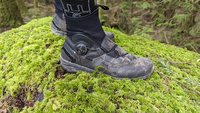Posted by: D_C_
^^^
I think his comment is referring to the speed the fork moves though its travel, not the speed the rider is moving forward.
That doesn't make a difference.
The energy that the system needs to absorb as part of a deceleration (either vertically in the case of an impact, or horizontally in the case of braking) would be related to the speed and mass of the rider.
The absorbed energy is the area under the spring force curve, a lighter rider has less kinetic energy and therefore needs less area under the curve to absorb it.
The actual spring force curve shape (how progressive or linear it is) is a separate thing. In general, a lighter rider is smaller and has smaller muscles which means the maximum force they can withstand is lower so adding a significant force ramp up at the end of the stroke probably won't work very well for them. On top of that, the lower leg ramp up becomes a big factor when dealing with smaller riders, as they can't adjust it and it becomes a big percentage of the total spring force when running lower pressures.
A light aggressive rider needs proportional support(force) at the end of the curve, they don't need equivalent support to a heavier rider, they would crumple
Lighter riders can benefit from more linear fork curves (with a tune-able end ramp) just as much as heavier riders







